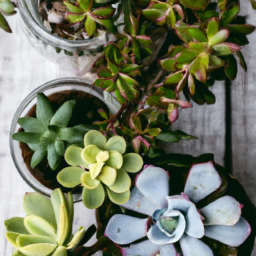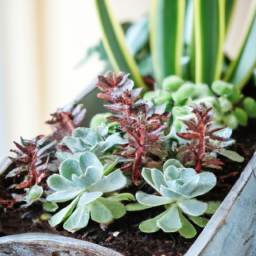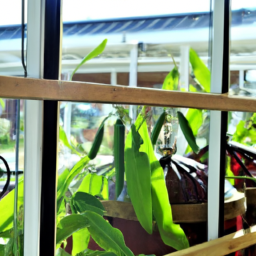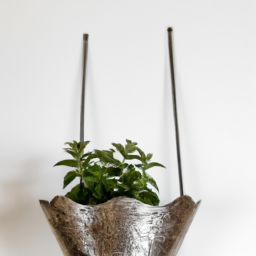
Are you looking to enhance the visual appeal of your succulent container garden? Well, you’ve come to the right place! In this blog post, we will be exploring the art of succulent container combinations and how to pair plants for maximum aesthetic appeal. Whether you’re a seasoned succulent enthusiast or just starting out, creating beautiful combinations of succulents can take your garden to the next level. So, let’s dive in and discover the secrets behind creating stunning succulent container combinations that will leave everyone in awe.
The Importance of Succulent Container Combinations in Creating Aesthetic Appeal
When it comes to succulent container combinations, pairing plants for aesthetic appeal is crucial. Succulents are known for their unique and captivating beauty, but the way they are arranged and combined can take their visual impact to a whole new level. In this guide, we will explore the importance of succulent container combinations and provide you with a step-by-step approach to create stunning arrangements.
Understanding the Power of Succulent Container Combinations
Creating an aesthetically pleasing succulent container combination is like painting a masterpiece. Just as different colors and brushstrokes come together to create a beautiful painting, different succulent varieties can be combined to form a visually striking arrangement. The right combination of succulents can enhance the overall appeal of your container garden, making it a focal point in your home or outdoor space.
Moreover, succulent container combinations allow you to play with textures, shapes, and colors. By carefully selecting and arranging succulents with varying leaf shapes, sizes, and colors, you can create a dynamic and visually interesting composition. The contrasting or complementary features of different succulent varieties can create a harmonious and eye-catching display.
Furthermore, succulent container combinations offer endless possibilities for creativity. You can experiment with different arrangements, mix and match various succulent species, and even incorporate other elements like rocks or driftwood to add depth and dimension to your composition. The possibilities are truly limitless, and the only limit is your imagination.
Step-by-Step Guide to Creating Succulent Container Combinations
Now that we understand the importance of succulent container combinations, let’s dive into the step-by-step process of creating your own visually appealing arrangement:
1. Selecting the Right Container
The first step is to choose a container that suits your style and complements the succulents you plan to pair. Consider the size, shape, and material of the container. Ensure that it has proper drainage holes to prevent waterlogging, as succulents are prone to root rot. You can opt for terracotta pots, ceramic containers, or even repurpose old items like teacups or wooden crates.
Remember, the container itself can contribute to the overall aesthetic appeal of your arrangement, so choose wisely.
2. Choosing Succulent Varieties
Next, select a variety of succulents that will thrive together and create a visually appealing combination. Consider factors such as growth habits, colors, textures, and sizes. It’s best to choose a mix of tall, trailing, and rosette-forming succulents to add depth and dimension to your arrangement.
Research different succulent species and their care requirements to ensure you provide them with the right conditions for growth. Some popular succulent choices include Echeveria, Sedum, Crassula, and Aloe.
3. Arranging the Succulents
Once you have your container and succulent varieties, it’s time to arrange them in a visually pleasing manner. Start by placing the tallest succulents in the center or at the back of the container. This will create a focal point and add height to your arrangement. Surround the taller succulents with medium-sized varieties, and finally, place trailing succulents around the edges to create a cascading effect.
Consider the colors and textures of the succulents as you arrange them. Mix and match different leaf shapes and colors to create an interesting contrast or opt for a monochromatic palette for a more cohesive look.
Don’t be afraid to experiment and rearrange the succulents until you achieve the desired composition. Remember, creating a visually appealing succulent container combination is an art form, and it may take some trial and error to find the perfect arrangement.
4. Providing Proper Care
Once your succulent container combination is complete, it’s essential to provide them with the care they need to thrive. Succulents generally prefer well-draining soil, so make sure your container has appropriate soil or use a cactus/succulent mix. Place your arrangement in a location that receives adequate sunlight, typically 4-6 hours of indirect or filtered sunlight per day.
Water your succulents sparingly, allowing the soil to dry out completely between waterings. Overwatering is one of the most common causes of succulent death, so it’s crucial to strike the right balance. Additionally, fertilize your succulents occasionally with a balanced, diluted succulent fertilizer to promote healthy growth.
By following these steps and experimenting with different succulent container combinations, you can create stunning arrangements that will enhance the aesthetic appeal of any space. Remember to have fun, let your creativity flow, and enjoy the process of creating your own succulent masterpiece!

Tips and Tricks for Pairing Succulent Plants for Stunning Container Combinations
Are you looking to create beautiful succulent container combinations that will enhance the aesthetic appeal of your space? Succulents are versatile plants that come in various shapes, colors, and textures, making them perfect for creating stunning arrangements. In this article, we will guide you through the process of pairing succulent plants to create visually pleasing container displays.
Understanding Succulent Characteristics
Before diving into the world of succulent combinations, it’s essential to understand the characteristics of different succulent plants. Succulents vary in terms of their growth habits, leaf shapes, colors, and sizes. Some succulents have rosette-shaped leaves, while others have trailing or upright growth patterns.
When selecting succulents for container combinations, consider their growth habits and ensure they complement each other. Pairing succulents with contrasting growth patterns can create a visually appealing display. For example, you can pair a rosette-shaped succulent with a trailing variety to add depth and dimension to your container.
Additionally, consider the colors and textures of the succulents. Succulents come in a wide range of colors, including shades of green, purple, blue, and even red. Some succulents have smooth leaves, while others have textured or spiky foliage. Combining succulents with different colors and textures can create an eye-catching arrangement.
Creating Harmonious Combinations
Now that you understand the characteristics of succulents let’s delve into the tips and tricks for creating harmonious combinations:
1. Consider the Container: The container you choose plays a significant role in the overall aesthetic of your succulent arrangement. Select a container that complements the colors and shapes of the succulents. For example, if you have succulents with vibrant foliage, opt for a neutral-colored container to let the plants take center stage.
2. Mix and Match Sizes: Pair succulents with different sizes to create visual interest. Combine small rosette-shaped succulents with taller, upright varieties to add height and drama to your arrangement. Alternatively, you can group succulents of similar sizes for a more uniform look.
3. Contrast Colors: Experiment with contrasting colors to make your succulent combination pop. Pair succulents with complementary colors, such as green and purple or blue and orange, to create an eye-catching display. However, be mindful of not overdoing it – a few carefully selected contrasting colors can have a more significant impact.
4. Pay Attention to Texture: Mixing succulents with different leaf textures can add depth and visual appeal to your container combination. Pair succulents with smooth leaves with those that have spiky or textured foliage. This contrast in textures creates an interesting focal point.
5. Balance the Arrangement: Achieving balance in your succulent container combination is crucial. Distribute the succulents evenly throughout the container, considering their growth habits and sizes. Avoid overcrowding the container, as it can hinder the growth and overall aesthetics of the succulents.
6. Consider Seasonal Variations: Some succulents display more vibrant colors during certain seasons. Take advantage of these seasonal variations to create ever-changing container combinations. Research the specific succulents you are working with to understand their seasonal characteristics and plan your combinations accordingly.
Maintaining Your Succulent Container Combination
Now that you have created a stunning succulent container combination, it’s important to maintain its beauty. Here are some essential tips for caring for your succulent arrangement:
1. Proper Watering: Succulents are known for their ability to store water in their leaves, stems, or roots. It’s crucial not to overwater them. Allow the soil to dry out between waterings, and ensure the container has proper drainage to prevent waterlogging.
2. Provide Adequate Sunlight: Succulents thrive in bright light conditions. Place your container in a location where the succulents can receive at least six hours of sunlight per day. However, be cautious of intense midday sun, as it can scorch the leaves of some succulent varieties.
3. Monitor Temperature and Humidity: Succulents generally prefer warm and dry conditions. Ensure the temperature and humidity levels in your space are suitable for the succulents you have chosen. Avoid exposing them to extreme temperature fluctuations or high humidity environments.
4. Regular Maintenance: Remove any dead or decaying leaves from the succulents to maintain their overall health and appearance. Additionally, keep an eye out for pests and treat any infestations promptly to prevent damage to your succulent container combination.
By following these tips and tricks, you can create stunning succulent container combinations that will enhance the aesthetic appeal of any space. Remember to experiment with different pairings, colors, and textures to find the perfect combination that suits your personal style. Enjoy the process of creating beautiful succulent arrangements and let your creativity flourish!

Exploring Different Succulent Varieties for Beautiful Container Pairings
When it comes to creating stunning succulent container combinations, the key lies in selecting the right varieties that complement each other in terms of color, texture, and growth habits. By carefully curating a collection of succulents, you can create a visually appealing arrangement that will be the envy of any garden enthusiast. In this guide, we will explore different succulent varieties and provide you with step-by-step instructions on how to pair them for aesthetic appeal.
1. Consider the Color Palette
The first step in creating beautiful succulent container combinations is to consider the color palette you want to work with. Succulents come in a wide range of colors, from vibrant greens to deep purples, and even shades of pink and orange. By selecting succulents that have complementary or contrasting colors, you can create a visually striking arrangement.
For example, you can pair a vibrant green Echeveria with a deep purple Sedum for a bold and eye-catching combination. Alternatively, you can create a more harmonious arrangement by selecting succulents that have similar shades of green, such as a Haworthia and a Crassula.
Remember to also consider the color of the container itself. A neutral-colored container can provide a backdrop for the succulents to shine, while a brightly colored container can add an extra pop of color to the arrangement.
2. Play with Texture
Another important aspect to consider when pairing succulents is their texture. Succulents come in a variety of shapes and textures, ranging from smooth and rounded to spiky and architectural. By combining succulents with different textures, you can create a visually interesting and dynamic arrangement.
For instance, you can pair a rosette-shaped Echeveria with a spiky Aloe for a contrasting texture combination. Alternatively, you can create a more cohesive look by selecting succulents that have similar textures, such as a collection of rosette-shaped succulents like Sedum and Sempervivum.
When arranging succulents with different textures, it’s important to consider the overall balance of the arrangement. Place taller succulents towards the center or back of the container, and use shorter succulents to fill in the front or edges.
3. Consider Growth Habits
Lastly, when pairing succulents for container combinations, it’s important to consider their growth habits. Some succulents grow tall and upright, while others have a trailing or cascading growth habit. By selecting succulents with different growth habits, you can create a visually dynamic arrangement with varying heights and cascading elements.
For example, you can pair a tall and upright Sansevieria with a trailing String of Pearls for an interesting contrast in height and growth habit. Alternatively, you can create a more uniform look by selecting succulents that have similar growth habits, such as a collection of trailing succulents like Sedum and Senecio.
When arranging succulents with different growth habits, it’s important to consider the overall balance of the arrangement. Place taller succulents towards the center or back of the container, and use trailing or cascading succulents to fill in the front or edges.
By considering the color palette, texture, and growth habits of different succulent varieties, you can create beautiful container pairings that are not only visually appealing but also thrive together. Experiment with different combinations and have fun creating your own unique succulent arrangements!
Here’s the Summary Snapshot
Succulent Container Combinations: Pairing Plants for Aesthetic Appeal
If you’re looking to add a touch of natural beauty to your home or garden, succulent container combinations are the way to go. These versatile plants come in a wide variety of shapes, sizes, and colors, making them perfect for creating visually stunning displays. Whether you’re a seasoned gardener or just starting out, pairing different succulent varieties can result in eye-catching arrangements that will surely impress.
When it comes to choosing succulents for your container combinations, the possibilities are endless. You can experiment with contrasting colors, textures, and heights to create a visually appealing display. For instance, pairing a spiky agave with a trailing sedum can create an interesting contrast in both shape and texture. Similarly, combining different shades of green, such as a jade plant and a haworthia, can result in a harmonious and calming arrangement. The key is to select plants that not only complement each other but also thrive in similar growing conditions. This way, you can ensure that your succulent container combinations not only look beautiful but also stay healthy and vibrant. So, don’t be afraid to get creative and experiment with different combinations – the results might just surprise you!
Check Out These FAQs:
Q1: What are succulent container combinations?
A1: Succulent container combinations refer to the art of pairing different types of succulent plants together in a single container to create visually appealing arrangements. By combining succulents with varying colors, textures, and growth habits, you can create stunning displays that enhance the overall aesthetic appeal of your space.
Q2: How do I choose succulents for container combinations?
A2: When choosing succulents for container combinations, consider their individual characteristics such as size, color, texture, and growth habit. Aim for a mix of upright, trailing, and rosette-shaped succulents to add variety and dimension to your arrangement. Additionally, select plants that have similar care requirements to ensure they thrive together in the same container.
Q3: What are some popular succulent combinations for aesthetic appeal?
A3: There are numerous popular succulent combinations that can create stunning aesthetic appeal. Here are a few examples:
- A combination of Echeveria ‘Lola’ (with pink rosettes) and Sedum ‘Burrito’ (with trailing stems) creates a beautiful contrast of colors and textures.
- Pairing Aloe ‘Blue Elf’ (with spiky blue-green leaves) and Senecio mandraliscae (with trailing blue-gray foliage) creates a visually striking arrangement.
- Combining Haworthia fasciata (with rosettes of striped leaves) and Graptoveria ‘Fred Ives’ (with rosettes of pinkish-purple leaves) offers a delightful mix of colors and patterns.
Remember, the possibilities are endless, and you can experiment with different combinations to find the ones that best suit your personal taste and style.
Q4: How do I care for succulent container combinations?
A4: Caring for succulent container combinations is relatively easy. Here are some general care tips:
- Provide ample sunlight: Succulents thrive in bright light, so place your container in a location where they can receive at least 6 hours of direct sunlight per day.
- Water sparingly: Succulents have low water needs and are prone to root rot if overwatered. Allow the soil to dry out completely between waterings and water only when the top inch of soil feels dry.
- Use well-draining soil: Succulents require well-draining soil to prevent waterlogged roots. Use a potting mix specially formulated for succulents or add perlite or coarse sand to regular potting soil to improve drainage.
- Monitor temperature and humidity: Most succulents prefer moderate temperatures and low humidity. Avoid exposing them to extreme heat or cold, and provide adequate ventilation to prevent fungal diseases.
- Occasional fertilization: Feed your succulents with a diluted, balanced fertilizer during the growing season (spring and summer) to promote healthy growth.
Always consider the specific care requirements of the succulents you have chosen, as they may vary slightly.
Q5: Can I mix succulents with other types of plants in container combinations?
A5: Yes, you can certainly mix succulents with other types of plants in container combinations. However, it’s important to choose companion plants that have similar care requirements and can tolerate the same growing conditions. Avoid combining succulents with plants that require frequent watering or prefer shaded environments, as this may lead to overwatering and poor growth for the succulents. Stick to plants that have similar water and light needs to ensure a harmonious and thriving container arrangement.

Lisa Chen is a seasoned indoor gardening expert and the author of several bestselling books on the topic. With a background in horticulture and urban farming, Lisa is dedicated to helping urban dwellers embrace the joys of cultivating green spaces indoors. Her detailed guides and hands-on tips empower readers to transform their living spaces into thriving plant sanctuaries.


